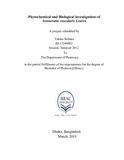| dc.contributor.advisor | Rahman, Imon | |
| dc.contributor.author | Sultana, Tahera | |
| dc.date.accessioned | 2018-05-15T03:30:33Z | |
| dc.date.available | 2018-05-15T03:30:33Z | |
| dc.date.copyright | 2018 | |
| dc.date.issued | 2018-03 | |
| dc.identifier.other | ID 12346002 | |
| dc.identifier.uri | http://hdl.handle.net/10361/10146 | |
| dc.description | This project report is submitted in partial fulfilment of the requirements for the degree of Bachelor of Pharmacy, 2018. | en_US |
| dc.description | Catalogued from PDF version of project report. | |
| dc.description | Includes bibliographical references (page 58-59). | |
| dc.description.abstract | Sonneratia Caseolaris is also known as mangrove apple belongs to the Lythraceae family.
These plants are very famous for their medicinal use worldwide especially in mangrove
regions. This plant is not only famous for their medicinal use but also for cooking. In this
particular study, in-vitro antioxidant activity of the methanol extract of Sonneratia Caseolaris
leaves was determined be DPPH (2,2 -diphenyl-1-picrylhydraziyl) free radical scavenging
assay. Brine shrimp lethality test was performed to determine the cytotoxic effect and the
LC50 value was calculated and has been compared to standard. | en_US |
| dc.description.statementofresponsibility | Tahera Sultana | |
| dc.format.extent | 59 pages | |
| dc.language.iso | en | en_US |
| dc.publisher | BRAC Univeristy | en_US |
| dc.rights | BRAC University project reports are protected by copyright. They may be viewed from this source for any purpose, but reproduction or distribution in any format is prohibited without written permission. | |
| dc.subject | Sonneratia caseolaris | en_US |
| dc.subject | Biological investigation | en_US |
| dc.title | Phytochemical and biological investigations of Sonneratia caseolaris leaves | en_US |
| dc.type | Project report | en_US |
| dc.contributor.department | Department of Pharmacy, BRAC University | |
| dc.description.degree | B. Pharmacy | |

